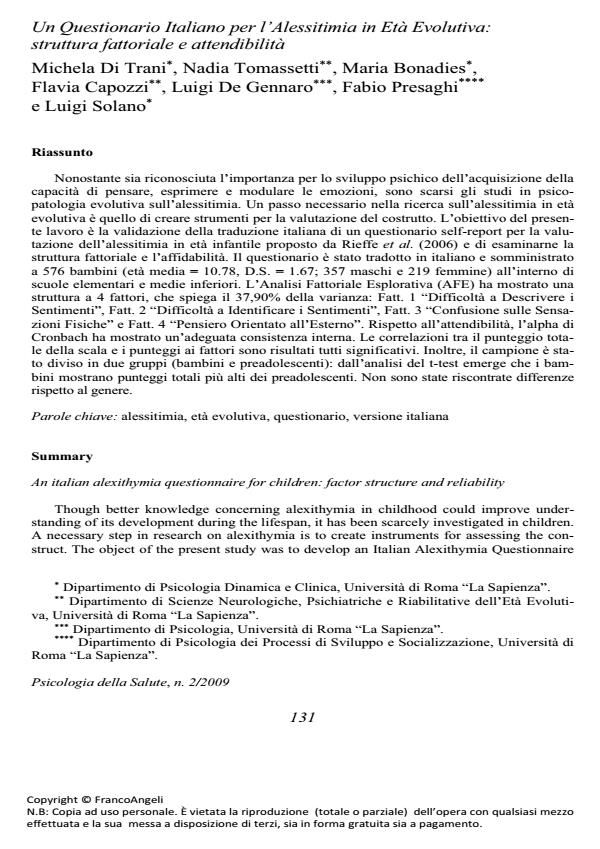Un Questionario Italiano per l’Alessitimia in Età Evolutiva: struttura fattoriale e attendibilità
Journal title PSICOLOGIA DELLA SALUTE
Author/s Michela Di Trani, Nadia Tomassetti, Maria Bonadies, Flavia Capozzi, Luigi De Gennaro, Fabio Presaghi, Luigi Solano
Publishing Year 2009 Issue 2009/2
Language Italian Pages 13 P. 131-143 File size 99 KB
DOI 10.3280/PDS2009-002009
DOI is like a bar code for intellectual property: to have more infomation
click here
Below, you can see the article first page
If you want to buy this article in PDF format, you can do it, following the instructions to buy download credits

FrancoAngeli is member of Publishers International Linking Association, Inc (PILA), a not-for-profit association which run the CrossRef service enabling links to and from online scholarly content.
An italian alexithymia questionnaire for children: factor structure and reliabilityThough better knowledge concerning alexithymia in childhood could improve understanding of its development during the lifespan, it has been scarcely investigated in children. A necessary step in research on alexithymia is to create instruments for assessing the construct. The object of the present study was to develop an Italian Alexithymia Questionnaire for Children based on the instrument proposed by Rieffe et al. (2006) and to examine its factor structure and reliability. The English version of the questionnaire was translated into Italian and it was administered to 576 children recruited from primary and secondary schools (age mean = 10.78, s.d. = 1.67; males 357 and 219 females). Exploratory Factor Analysis (EFA) revealed preliminary evidence of a four-factor structure, which explained 37.90% of the variance: Factor 1 "Difficulty Describing Feelings", Factor 2 "Difficulty Identifying Feelings", Factor 3 "Confusion on Physical Sensations" and Factor 4 "Externally-Oriented Thinking". As to reliability, the Cronbach alpha indicated adequate internal consistency. Pearson correlations among the total score and the four factors were statistically significant. Moreover, the sample was divided into two groups (children and pre-adolescents) and a ttest was conducted: children showed significantly higher scores than adolescents on the total score of the questionnaire. No significant gender differences in mean total scores were found.
Key words: alexithymia, childhood, questionnaire, Italian version
Parole chiave: alessitimia, età evolutiva, questionario, versione italiana
- Emotional processes and stress in children affected by hereditary angioedema with C1-inhibitor deficiency: a multicenter, prospective study Livia Savarese, Maria Bova, Raffaella De Falco, Maria Domenica Guarino, Raffaele De Luca Picione, Angelica Petraroli, Riccardo Senter, Claudia Traverso, Matteo Zabotto, Andrea Zanichelli, Eugenio Zito, Maria Alessio, Mauro Cancian, Marco Cicardi, Adriana Franzese, Roberto Perricone, Gianni Marone, Paolo Valerio, Maria Francesca Freda, in Orphanet Journal of Rare Diseases 115/2018
DOI: 10.1186/s13023-018-0871-x - Stress and Psychological Factors in the Variable Clinical Phenotype of Hereditary Angioedema in Children: A Pilot Study Maria Francesca Freda, Livia Savarese, Maria Bova, Anna Galante, Raffaella De Falco, Raffaele De Luca Picione, Gianni Marone, Angelica Petraroli, Gerarda Siani, Paolo Valerio, Massimo Triggiani, in Pediatric Allergy, Immunology, and Pulmonology /2016 pp.6
DOI: 10.1089/ped.2015.0557 - Alexithymia in children with medically unexplained symptoms: a systematic review Maria Hadji-Michael, Eve McAllister, Colin Reilly, Isobel Heyman, Sophie Bennett, in Journal of Psychosomatic Research 109736/2019 pp.109736
DOI: 10.1016/j.jpsychores.2019.109736 - Eating Disorders Cecilia Serena Pace, Stefania Muzi, Wanda Morganti, pp.313 (ISBN:978-3-031-16690-7)
- The Dysfunction of Emotional Expression as a Related Factor for Alcohol Misuse in Young Adolescents Michela Gatta, Andrea Spoto, Elena Colombo, Marco Penzo, Pier Antonio Battistella, in Journal of Child & Adolescent Substance Abuse /2017 pp.30
DOI: 10.1080/1067828X.2016.1184599 - Alexithymia and psychosocial problems among Italian preadolescents. A latent class analysis approach Stefania Mannarini, Laura Balottin, Irene Toldo, Michela Gatta, in Scandinavian Journal of Psychology /2016 pp.473
DOI: 10.1111/sjop.12300 - Eating Disorders Cecilia Serena Pace, Stefania Muzi, Wanda Morganti, pp.1 (ISBN:978-3-030-67929-3)
- Alexithymia in juvenile primary headache sufferers: a pilot study Michela Gatta, Elisabetta Canetta, Maria Zordan, Andrea Spoto, Emilia Ferruzza, Irene Manco, Alessandra Addis, Lara Dal Zotto, Irene Toldo, Stefano Sartori, Pier Antonio Battistella, in The Journal of Headache and Pain /2011 pp.71
DOI: 10.1007/s10194-010-0248-6 - A comprehensive approach to understand somatic symptoms and their impact on emotional and psychosocial functioning in children Rita Cerutti, Valentina Spensieri, Carmela Valastro, Fabio Presaghi, Roberto Canitano, Vincenzo Guidetti, Giuseppe Curcio, in PLOS ONE /2017 pp.e0171867
DOI: 10.1371/journal.pone.0171867 - Alexithymia in food-allergic versus healthy children and young adults Laura Polloni, Dario Gregori, Emilia Ferruzza, Cristina Oricoli, Francesca Lazzarotto, Roberta Bonaguro, Alice Toniolo, Nicolò Celegato, Antonella Muraro, in Journal of Health Psychology /2017 pp.228
DOI: 10.1177/1359105315600235
Michela Di Trani, Nadia Tomassetti, Maria Bonadies, Flavia Capozzi, Luigi De Gennaro, Fabio Presaghi, Luigi Solano, Un Questionario Italiano per l’Alessitimia in Età Evolutiva: struttura fattoriale e attendibilità in "PSICOLOGIA DELLA SALUTE" 2/2009, pp 131-143, DOI: 10.3280/PDS2009-002009